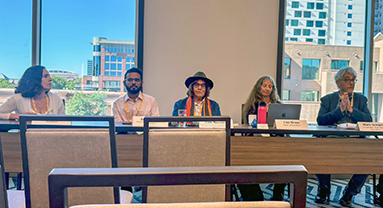 This is the 2nd in a series of feature stories on environmental topics by Knight Center students who attended the 2025 Society of Environmental Journalists conference.
This is the 2nd in a series of feature stories on environmental topics by Knight Center students who attended the 2025 Society of Environmental Journalists conference.
By Ruth Thornton

Ruth Thornton
The widespread use of several potent pesticides remains a problem in several countries, according to investigative reporters.
Their research shows that the often-cozy relationship between government officials who issue permits and the industry endangers not only the environment but also human lives.
The reporters discussed their reporting on a panel at this year’s Society of Environmental Journalists’ annual conference at Arizona State University.
Panel members were Liza Gross, a reporter with Inside Climate News, Sanket Jain, an independent journalist, Talli Nauman, a contributing editor at Buffalo’s Fire, and Carla Ruas, a freelance journalist. The panel was moderated by Mark Schapiro, an investigative journalist and lecturer at the University of California, Berkeley Graduate School of Journalism.
Toxic fumigant pesticide use in California
The “toxic fumigant 1,3-D should probably not be on the market, because it’s been known to be a carcinogen for years,” Gross said.
The fumigant 1,3-D, short for 1,3-Dichloropropene, is a pesticide also known under its tradename Telone. It is applied to farm soils to control nematodes, a type of worm that can harm crops, according to the Environmental Protection Agency. It was first registered in the 1950s.

SEJ Pesticide Panel
Gross said she originally focused on that chemical when an advocacy group in California was upset that regulators in the state proposed standards that would have exposed residents near application sites to about 14 times the safe amount.
“When I started looking into 1,3-D’s regulatory history, I found some troubling things that were going on at the federal level,” Gross said.
“It was pretty clear, without that much digging, that I could test the idea that there was regulatory capture going on there,” she said.
Regulatory capture is a political and economic term that describes a situation where regulators become unduly influenced by the industries they regulate.
Some examples, she said, are more obvious than others.
Lobbying, for instance.
Agencies like California’s Department of Pesticide Regulation and the EPA, she said, “have lobbyists coming in and out constantly.”
“And the people who are the most affected by the exposures to those chemicals that produce harm generally do not have the resources to do that,” she said.
Industry conflicts of interest with regulatory agencies
Another example of regulatory capture, Gross said, is people from the chemical industry ending up in regulatory agency jobs.
Because they often still have close ties with people in the industry, they “tend to come up with pretty complex technical ways to show that the chemical or pesticide of interest isn’t as harmful as independent researchers might say,” she said.
Gross said in the stories she reported, private companies like Dow retained what she called “science for hire” groups like SciPinion.
“These guys, basically, never met a chemical they couldn’t defend,” she said.
And even though the EPA had first found the fumigant 1,3-D to cause cancer in the 1980s, Dow has been trying to get its cancer-causing classification downgraded ever since, Gross said.
“They hired SciPinion to do a review of the literature,” Gross said, and “they basically threw out a bunch of studies that were done by independent researchers that found evidence of harm.”
1,3-D is still approved for use in the U.S. and is one of the most heavily used pesticides in California, according to Californians for Pesticide Reform and the University of California, Davis Environmental Health Sciences Center. It is banned in 34 countries, including those in the European Union.
The use of potentially harmful chemicals is not confined to the U.S., however.
Harmful insecticide use in Mexico
Nauman reported on a group of farm workers in Mexico protesting for better working conditions.
“These are families from the southern part of Mexico who are Indigenous. They’re itinerant workers,” she said.
They told her they did not know what pesticides they were exposed to.
“But we keep seeing these bags around here called Tamaron,” they told her, she said.
When she looked up the chemical, she found that Tamaron, an insecticide with the active ingredient Methamidophos, is one of the most acutely toxic organophosphate pesticides, according to the EPA.
It has been banned in the U.S. since 2009.
Nauman said the workers were not provided training or protective clothing.
Schapiro, the panel moderator, added “And guess what? Pesticides come back in the residues of food, fruits and vegetables that we import to the United States.”
Organophosphate chemicals sprayed in India
Jain reports on the intersection between climate change and pesticides.
He said the heat caused by global warming is making it more dangerous to spray some chemicals.
“Let’s say you’re trying to spray pesticides in 130 degrees Fahrenheit,” Jain said. “Pesticides turn into gas very easily when it’s so hot outside.”
“And it’s not just the farmer who is inhaling this – there are communities who are nearby, they are inhaling this,” he said.
That includes the toxic organophosphate group of insecticides.
This class “is very dangerous and is banned in many countries in the Global North, but they are readily exported to the Global South,” he said.
“In India, it’s available very easily – just call up a store and you’ll get it delivered,” Jain said.
He told the story of a 38-year-old farmer he had interviewed who sprayed pesticides in the heat.
“And I went back to him after six months, but I couldn’t find him because he was gone. He had died of pesticide poisoning,” he said.
Cases of pesticide poisoning are not always easy to identify, however, especially in adults who have been exposed to other risk factors such as alcohol or tobacco, Ruas said.
Pesticide effects on children in Brazil
That’s why Ruas teamed up with the environmental health scientist Tatiane Moraes de Sousa at the University of São Paulo to investigate rates of still births and birth defects in Brazil’s agricultural areas.
What they found was sobering: In municipalities with intense agriculture and widespread pesticide use, the risk of still births was up to 73% higher and for birth defects up to 20% higher.
When they set out to interview affected families, however, many were not willing to speak on the record.
“Many of these families were agricultural workers and worked in agribusiness, which is a very powerful economic, political and cultural sector in Brazil,” Ruas said.
“Many families were hesitant to speak out of fear of retaliation, and even those who agreed to be interviewed in person later called us and asked us not to publish their stories,” she said.
Ruas said given that Brazil is the world’s leading user of pesticides as of 2022, according to the United Nations Food and Agriculture Organization, she was struck by the lack of coverage of the impacts of pesticide exposure.
And even pesticides restricted in the U.S. or the European Union are freely available in Brazil.
“Brazil lacks regulation and is on the receiving end of many of these banned and controlled pesticides in the Global North, and we represent an enormous market for these companies,” she said.
